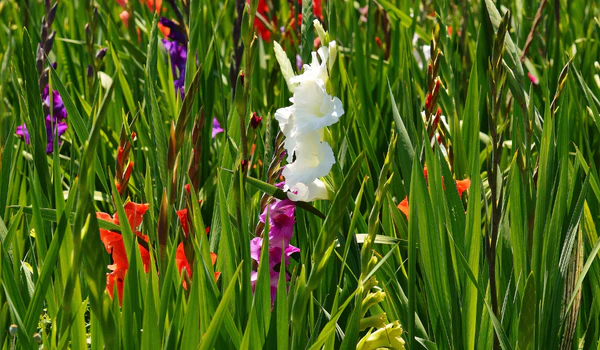khakisofirvington.com – Gladiolus, often referred to as “sword lilies,” are known for their striking, tall spikes of colorful flowers. With their vibrant hues and elegant structure, gladioli are popular in both gardens and floral arrangements. These flowers, part of the Iridaceae family, have been grown for centuries, admired for their beauty and ability to stand tall in the landscape. If you’re looking to add a dramatic and elegant touch to your garden, gladiolus flowers are the perfect choice. Here’s everything you need to know about growing and caring for these magnificent blooms.
Appearance and Characteristics
Gladiolus flowers are renowned for their tall, spiky stems, which can reach heights of 2 to 5 feet depending on the variety. Each stem features a series of funnel-shaped flowers that open from the bottom upwards, creating a cascading effect of blooms. The flowers themselves are large and vibrant, available in a wide array of colors, including red, pink, purple, yellow, white, and even bicolor varieties.
The foliage of the gladiolus plant consists of long, narrow, sword-like leaves, which complement the shape of the flowers. The flowers’ tubular form and vivid colors make gladiolus a striking focal point in any garden. Gladiolus blooms are typically in full display during the summer months, creating a dramatic presence that adds vertical interest and elegance.
Planting and Growing Conditions
Gladiolus bulbs, also known as corms, are typically planted in spring, after the last frost has passed. These plants thrive in full sun, requiring at least 6 hours of direct sunlight per day for optimal growth and flowering. Gladiolus prefer well-drained soil that is rich in organic matter. It is important to avoid planting them in areas where the soil retains too much moisture, as they do not tolerate soggy conditions.
When planting gladiolus, space the corms about 4 to 6 inches apart, planting them 3 to 4 inches deep into the soil. If you are planting multiple rows, space them 12 to 18 inches apart to ensure proper air circulation and give the plants enough room to grow. Planting gladiolus corms at different times during the spring can help ensure a staggered blooming period, allowing for continuous color throughout the summer.
Care and Maintenance
Gladiolus are relatively easy to grow but require some attention to ensure healthy growth and vibrant blooms. During the growing season, gladiolus need consistent watering to keep the soil evenly moist. However, it’s essential not to overwater, as this can lead to bulb rot. Once the flowers begin to bloom, water less frequently, as the plants will not need as much moisture.
Fertilizing gladiolus is important for encouraging strong, healthy growth. A balanced fertilizer can be applied every 4 to 6 weeks during the growing season. Gladiolus will benefit from extra feeding when they begin to bloom, as this helps sustain their flowers.
Deadheading, or removing spent flowers, is recommended to maintain the plant’s appearance and encourage the development of new blooms. However, it’s best to leave the foliage intact until it has naturally died back, as the leaves help the plant store energy for the next growing season.
Pests and Problems
Gladiolus are relatively pest-resistant, though they can occasionally be affected by common garden pests such as aphids, thrips, and spider mites. Aphids can be controlled using insecticidal soap or by introducing natural predators like ladybugs. Thrips are another common pest of gladiolus and can cause damage to flowers. To prevent thrips, practice good garden hygiene and remove affected flowers as soon as you notice damage.
Gladiolus can also be prone to fungal diseases, such as botrytis blight, especially in humid or damp conditions. To reduce the risk of fungal infections, ensure good air circulation around the plants, avoid overhead watering, and remove any dead or diseased foliage promptly. In areas with high humidity, you may also want to apply a fungicide as a preventative measure.
Uses in Landscaping
Gladiolus are perfect for adding height and drama to the garden. They can be planted in borders, along fences, or in mixed perennial beds where their tall flower spikes will stand out. Gladiolus are particularly effective when grouped together in large clusters, creating a striking visual effect.
Their bold vertical lines also make them ideal for planting as a backdrop in garden beds, providing structure and contrast to shorter plants. Gladiolus can be paired with other summer-blooming flowers such as dahlias, lilies, and sunflowers to create a colorful, layered effect.
In addition to their beauty in the garden, gladiolus flowers are widely used as cut flowers in bouquets and floral arrangements. The long stems and colorful blooms make them a popular choice for creating elegant centerpieces, wedding bouquets, and other special occasion arrangements.
Growing Gladiolus in Containers
If you don’t have a large garden, gladiolus can also be successfully grown in containers. Choose a large pot or container with drainage holes and fill it with well-draining, fertile soil. Plant the gladiolus corms in the container in the same way as in the ground, spacing them about 4 to 6 inches apart. Containers should be placed in a sunny location to ensure proper flowering.
Growing gladiolus in containers makes it easy to move them around to different areas of your garden, allowing you to experiment with different settings or bring them indoors when they bloom for a dramatic display.
Conclusion
Gladiolus flowers are an elegant and vibrant addition to any garden, offering towering spikes of color that bring drama and vertical interest to the landscape. With their range of colors, striking structure, and ability to attract attention, gladiolus can be a focal point in flower beds, borders, and containers. Easy to grow and maintain, gladiolus provide months of beauty, making them a must-have for gardeners seeking to add bold blooms to their outdoor spaces. Whether as a cut flower or a stunning garden feature, gladiolus flowers are sure to impress and delight.
